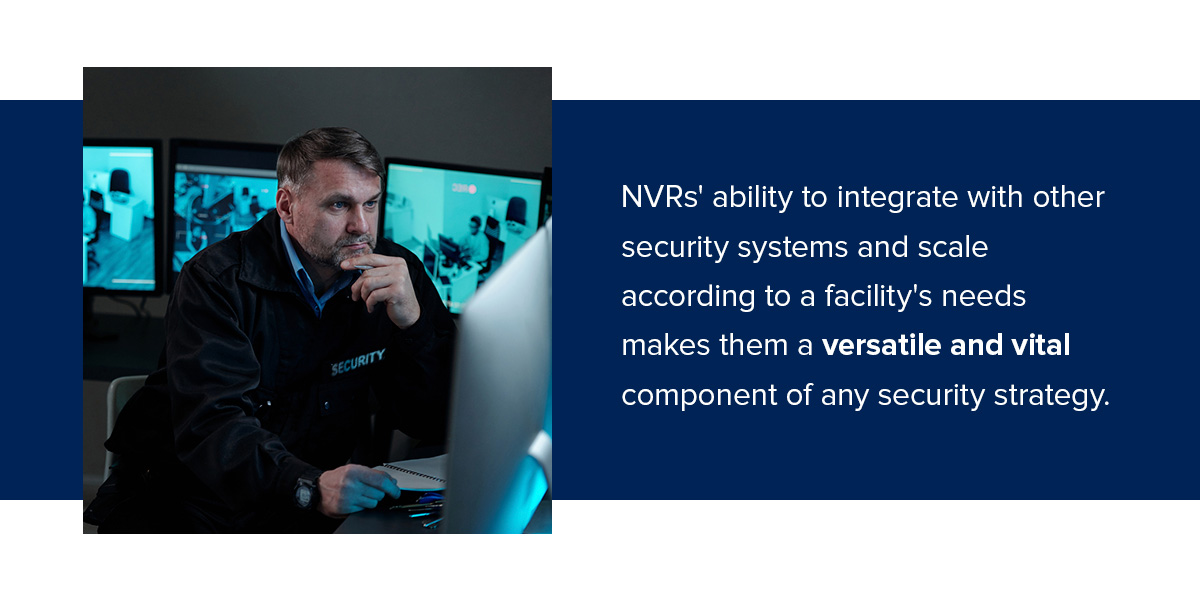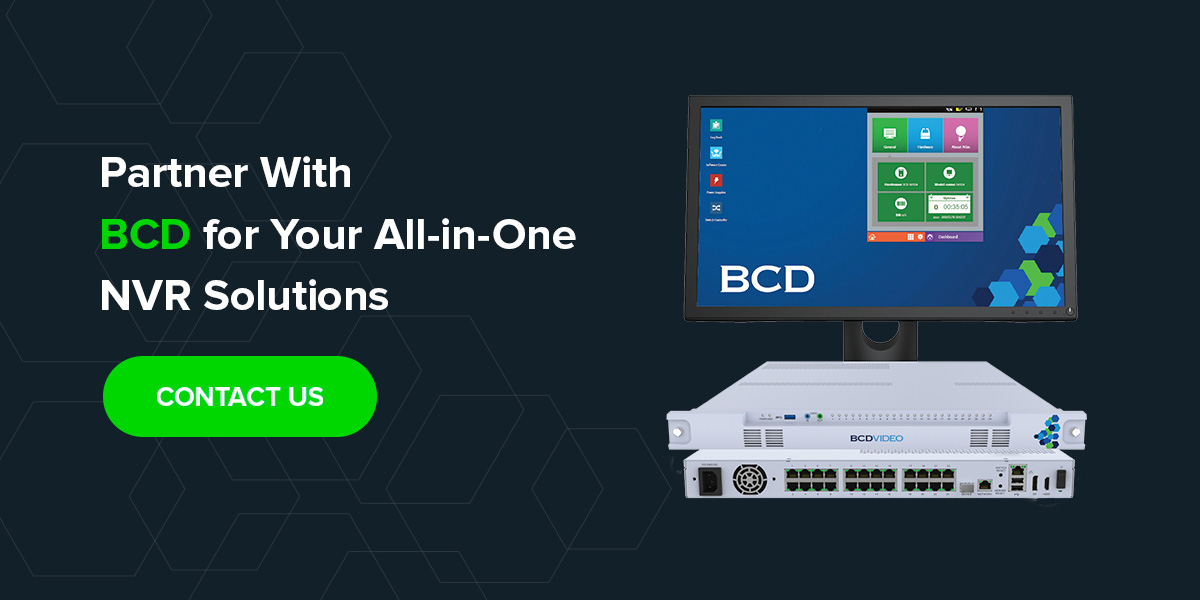A multiple network video recorder (NVR) records and stores video from IP cameras. Determining how many NVRs your security deployment requires depends on several factors, including the number of cameras, their resolutions and the maximum storage capacity for video footage.
Security system integrators design and deploy video surveillance systems for various clients and projects. They estimate the number of NVRs required for optimal performance and try not to underestimate or overestimate. An NVR must handle high-resolution cameras and multiple streams without lag and have scalability options.
If you’re an integrator looking to configure a security deployment and are considering using NVRs, here are key pieces of information to help answer commonly asked questions.
The Role of NVRs in Security Deployments
An NVR is a device used in video surveillance systems to record and save video from security cameras. Unlike traditional DVRs, which are designed for analog cameras, NVRs work with IP cameras that send video data over a network. NVRs allow users to access, manage, and playback recorded video remotely via the Internet. Compared to older technologies, NVRs provide flexibility and better image quality. They’ve formed a crucial part of modern security systems.
Their features make them ideal for various settings, from small businesses to large facilities.
- Video and data management: NVRs manage the data streams coming from multiple IP cameras and ensure all footage is saved for later review. Flexible storage options, including cloud storage and local storage on hard drives, allow users to choose the best solutions for their needs.
- Real-time monitoring: NVRs can monitor live video feeds from connected cameras. Users can view real-time footage remotely through computers, tablets or smartphones. NVRs can support multiple cameras simultaneously, allowing users to monitor various facility areas simultaneously.
- Access and control: Many NVRs offer interfaces or apps that enable authorized users to access video feeds and recordings from anywhere with an internet connection. Some NVRs can be upgraded to include user management features to control access and elevators.
- Alerts and notifications: NVRs can be configured to send alerts or notifications when specific events occur to help security teams respond quickly to potential threats. Users can also prevent considerable surveillance downtime with SMS or email notifications.
- Seamless integration: NVRs allow for centralized management of various security devices, simplifying operations and reducing the complexity of monitoring multiple systems. They can connect cameras, networks, servers and workstations.
- Scalability and flexibility: Many NVRs support a modular design that allows you to add new features or capabilities for clients without replacing the entire system. Depending on the setup, NVRs can be scaled to accommodate additional cameras and storage as security needs grow.

Frequently Asked Questions About NVRs
NVRs’ ability to integrate with other security systems and scale according to a facility’s needs makes them a versatile and vital component of any security strategy. Learn more about the number of cameras NVRs can support and how many NVRs you need for your security deployment.
1. How Many Cameras Does an NVR Support?
The number of cameras an NVR can support depends on the type of NVR system and its channel configuration. Each channel typically supports one camera. Common configurations include four, eight, 16 and 32 channels, but some NVRs may offer additional channels for increased capacity:
- 4- and 8-channel NVRs: These configurations are ideal for small retail stores or offices and are suitable for basic video surveillance needs.
- 16-channel NVRs: This is a good choice for businesses that must monitor several areas while being mindful of budget constraints. It allows for more cameras in the future without significantly increasing costs.
- 32-channel or more NVRs: These configurations are recommended for larger facilities, such as warehouses, municipal buildings or factories that require extensive camera coverage to ensure security.
The exact number of channels needed depends on the number of security cameras deployed and how many more may be required for complete coverage in the future. Opting for a 16- or 32-channel NVR will allow growth without replacing the entire system. Also, using PTZ cameras can help reduce the number of cameras needed to cover larger areas.
2. How Many NVRs Do You Need?
Determining how many NVRs are needed for your security deployment depends on several factors. Here’s a breakdown of the considerations to help you make an informed decision:
- Number of cameras: Each NVR has a specific number of channels it can support. A good general rule of thumb is one NVR for every 16 to 32 cameras for small businesses, depending on resolution and bitrate.
- Camera resolution and bitrate: Higher resolution cameras require more bandwidth and processing power. Higher bitrates also result in larger files, which occupy more storage space. You’ll either need more NVRs to handle the increased data load of high-resolution cameras or an NVR with more channels. This will ensure smooth performance.
- Deployment size and layout: Consider the size of the area that needs to be monitored. Larger facilities may require multiple NVRs to cover different sections effectively. However, in critical security situations, having multiple NVRs can provide redundancy. If one NVR fails, others can continue recording to ensure no footage is lost.
If you deploy more than one NVR, ensure the network can support the data load from multiple NVRs and cameras.
3. How Do You Calculate the Number of NVRs Required?
You can calculate the number of NVRs you need by determining the number of cameras and dividing it by the NVR’s channel capacity.
- Number of cameras / number of channels on NVR = number of NVRs needed
For example, say you have a security deployment that includes 50 IP cameras, and you choose an NVR model that supports 32 channels.
- 50 cameras / 32 channels per NVR = 1.5625
If your answer is a fraction, round up to the next whole number. In this example, you will need two NVRs to support 50 cameras.
However, calculating the number of NVRs required is often based on multiple other factors, especially storage space. To determine your NVR’s space requirements, use the following formula:
- Storage space (GB) = Bitrate (kbps) * (1,000 / 8) * 3,600 * 24 * cameras * days / 1,000,000,000
Where:
- Bitrate (kbps) is the bitrate of each camera in kilobits per second.
- Cameras are the total number of cameras in the system.
- Days is the total number of days you want to record.
- 1,000 / 8 converts kbps to bytes.
- 3,600 converts seconds to hours.
- 24 converts hours to days.
- 1,000,000,000 converts bytes to gigabytes (GB).
Now, let’s say the 50 cameras each have a maximum bitrate of 1,024 kbps, and you want to record nonstop for seven days.
- Storage space (GB) = 1,024 kbps * (1,000 / 8) * 3,600 * 24 * 50 * 7 / 1,000,000,000
- Storage space (GB) = 3,870.72
Then, check the NVR specifications to see how much storage it can handle. For example, suppose the NVR you have in mind supports 80TB of storage, which is 80,000 GB.
Divide the total required storage by the capacity of one NVR:
- 3,870.72 GB / 80,000.00 GB = 0.0048
Rounding up, you would only need one NVR to support this camera setup’s storage capacity.
4. Is Having One NVR for All Cameras or Multiple NVRs for Different Areas Better?
It depends on your security requirements, budget and future expansion plans. One NVR is suitable for smaller installations where ease of management and cost-effectiveness are priorities. In contrast, multiple NVRs are the better choice for larger, more complex deployments where redundancy, scalability and performance are critical factors.
Partner With BCD for Your All-in-One NVR Solutions
When calculating the number of NVRs needed for your security deployment, you must assess various factors, including the number of cameras, their resolutions and the required storage. You should also consider potential units’ scalability features to allow for easy upgrades as security needs grow. An all-in-one NVR is ideal for many environments, from small businesses to large retailers.
BCD’s all-in-one NVR integrates seamlessly with various IP cameras and other security technologies and is designed to provide scalability for future expansions. It stores up to 80 TB of video footage and has a switch with 24 ports that can connect to PoE devices. Powered by an Intel Core i7-7700 processor, the NVR processes video data quickly and ensures smooth performance, especially when recording from multiple cameras simultaneously.
Partner with BCD for your next integrated security deployment. Get in touch for a quote today.


